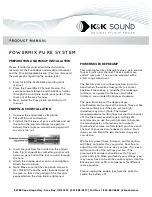
CS616 and CS625 Water Content Reflectometers
7.4 Operating Range
7.4.1 Soil Electrical Conductivity
The quality of soil water measurements which apply electromagnetic fields to
wave guides is affected by soil electrical conductivity. The propagation of
electromagnetic fields in the configuration of the CS616/CS625 is
predominantly affected by changing dielectric constant due to changing water
content, but it is also affected by electrical conductivity. Free ions in soil
solution provide electrical conduction paths which result in attenuation of the
signal applied to the waveguides. This attenuation both reduces the amplitude
of the high-frequency signal on the probe rods and reduces the bandwidth. The
attenuation reduces oscillation frequency at a given water content because it
takes a longer time to reach the oscillator trip threshold.
It is important to distinguish between soil bulk electrical conductivity and soil
solution electrical conductivity. Soil solution electrical conductivity refers to
the conductivity of the solution phase of soil. Soil solution electrical
conductivity,
σ
solution
can be determined in the laboratory using extraction
methods to separate the solution from the solid and then measuring the
electrical conductivity of the extracted solution.
The relationship between solution and bulk electrical conductivity can be
described by (Rhoades et al., 1976)
σ
σ
θ
σ
bulk
solution
=
+
v
solid
Τ
with
σ
bulk
being the electrical conductivity of the bulk soil;
σ
solution
, the soil
solution;
σ
solid
, the solid constituents;
θ
v
, the volumetric water content; and
Τ
,
a soil-specific transmission coefficient intended to account for the tortuosity of
the flow path as water content changes. See Rhoades et al., 1989 for a form of
this equation which accounts for mobile and immobile water. This publication
also discusses soil properties related to CS616/CS625 operation such as clay
content and compaction. The above equation is presented here to show the
relationship between soil solution electrical conductivity and soil bulk
electrical conductivity.
Most expressions of soil electrical conductivity are given in terms of solution
conductivity or electrical conductivity from extract since it is constant for a
soil. Bulk electrical conductivity increases with water content so comparison
of the electrical conductivity of different soils must be at same water content.
Discussion of the effects of soil electrical conductivity on CS616/CS625
performance will be on a soil solution or extract basis unless stated otherwise.
When soil solution electrical conductivity values exceed 2 dS m
-1
, the response
of the CS616/CS625 output begins to change. The slope decreases with
increasing electrical conductivity. The probe will still respond to water content
changes with good stability, but the calibration will have to be modified. (See
Section 8,
Water Content Reflectometer User-Calibration
.) At electrical
conductivity values greater than 5 dS m
-1
the probe output can become unstable.
31
Summary of Contents for CS616
Page 2: ......
Page 8: ...Table of Contents iv ...
Page 50: ...CS616 and CS625 Water Content Reflectometers 42 ...
Page 52: ...Appendix A Discussion of Soil Water Content A 2 ...
Page 53: ......
















































